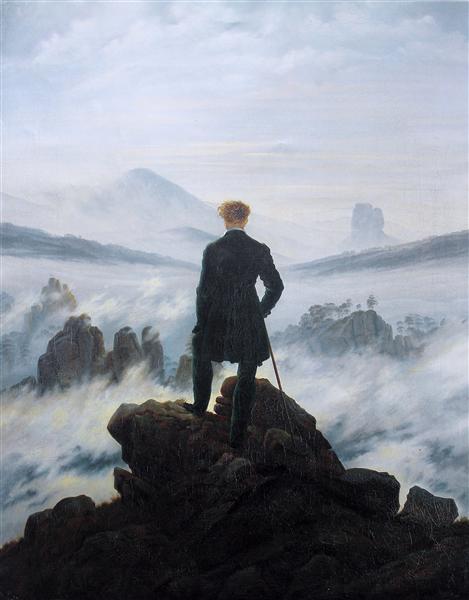Beskrivelse
The work "The Wanderer Above the Sea of Fog", painted by Caspar David Friedrich in 1818, is a splendid example of German Romanticism and has become one of the most iconic images of the painting of this period. Friedrich, a master in the representation of landscapes that evoke the sublime connection between human beings and nature, offers us in this painting a profound symbolism about introspection and the search for the individual's place within a vast universe.
In the foreground, an elegantly dressed man in a dark coat and classic-cut trousers stands firmly on a high rock. His posture is energetic but contemplative, suggesting a state of reflection. The figure, whose face remains in shadow, seems to contemplate a landscape covered by a dense sea of fog. This choice of not showing his face allows the viewer to project themselves into the figure of the walker, inviting them to share this experience of discovery and wonder at the unknown.
The composition is carefully balanced, with the hiker positioned in a prominent spot that captures the viewer’s attention. The sharp rocks surrounding him seem to foreshadow both the grandeur and the eeriness that the hazy horizon represents. This focus on the human figure reinforces the romantic idea of individuality and the essence of the personal journey, both external and internal. Friedrich uses the negative space of the mist spreading across the landscape to create a sense of immediacy, as if the viewer is on the verge of a transcendent discovery.
The use of colour in the work is also noteworthy. The greyish and blueish tones of the sea of fog contrast with the walker’s white T-shirt and dark coat. This colour palette not only highlights the central figure, but also evokes an atmosphere of melancholy, a characteristic feature in many of Friedrich’s works. The play between shadow and light suggests an emotional ambiguity: fog can symbolise both confusion and possibility.
Friedrich, often considered a pioneer in depicting nature as a reflection of the inner state of the human being, here offers us a meditation on solitude and connection with the natural environment. As in his other works, such as "The Abbot in a Pine Forest" or "The Offering of the Virgin", the landscape becomes a mirror of deep emotions. His ability to infuse the environment with a sense of personal meaning and existence is what distinguishes him as one of the greatest Romantic landscape painters.
Friedrich's painting does not merely place the wanderer upon a sea of fog; it places him on the threshold of the unknown. The fog suggests mystery and potential, while the solid rock represents the certainty of present experience. This duality encapsulates the essence of Romantic humanism: a struggle to discover not only the outside world, but also the vast landscapes of the human psyche.
"The Wanderer Above the Sea of Fog" is, therefore, more than just a landscape; it is a masterpiece that invites contemplation and questioning. At its core, it reflects the deep connection between the individual and his or her environment, a recurring theme in Romanticism that continues to resonate powerfully in contemporary art. Through his landscapes, Friedrich captures the vulnerability and wonder of the human being before the grandeur of nature, turning each glance at this painting into an invitation to lose oneself in reflection and to find, perhaps, something of what we all seek: a sense of belonging and understanding within the vast mystery of existence.
KUADROS ©, a famous painting on your wall.
Hand-made oil painting reproductions, with the quality of professional artists and the distinctive seal of KUADROS ©.
Painting reproduction service with satisfaction guarantee. If you are not completely satisfied with the replica of your painting, we will refund 100% of your money.

